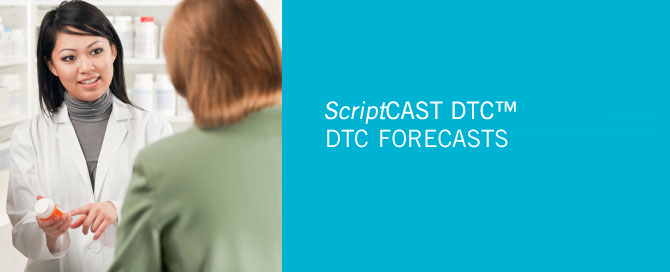DTC Forecasts

ScriptCAST DTC™ ADVERTISING SIMULATION
PBE’s ScriptCAST DTC simulation has been specifically adapted to address the unique problems posed by DTC campaigns. For example, DTC campaigns can generate incremental volume for the advertised brand by:
- Bringing in individuals who are not currently treated for the medical condition at all.
- Causing individuals who are currently treated with a competitive medication to request and receive the advertised brand.
- Increasing the compliance rates of individuals currently using the advertised brand.
- Increasing the persistency rates of individuals currently using the advertised brand.
- Increasing the probability that the physician prescribes the advertised brand for individuals who don’t request it.
- Increasing the probability that the physician grants the patient’s request
- Causing the category itself to grow.
ScriptCAST DTC can capture, model, and forecast all of these sources of incremental business.
ScriptCAST DTC utilizes a methodology that addresses the specific dynamics of the prescription drug process, which, in many respects, deviates significantly from the OTC dynamic. For example, the probability that an individual requests the medication has to be determined, the probability that the physician grants the request has to be determined, the probability that the patient fills the Rx has to be determined. This last component is especially important. Most patients requesting a medication they’ve seen advertised have no idea what it costs. For those without third party coverage, this is an extremely critical issue. If, when they arrive at the pharmacy, they discover that the medication costs $100 a month, they may not fill the Rx at all. This is known as the “sticker-shock” factor. Even individuals with copay plans will often opt not to switch to the advertised drug when they discover a copayment is necessary or that the copayment is greater than what they have been paying for a competing drug.
To assure that the DTC advertising forecast does not overstate the incremental business generated by the campaign, it’s necessary to subtract out all those Rx’s filled in response to requests that would have been filled anyway had the requests not been made. The logic of the final model for the forecast, for any time interval, is:
(A x B x C x D x E) – (A x B x C x D x E x F) x G
where,
A = Marketing Factor (promotion)
B = probability that patient requests the brand
C = probability that physician grants patient’s request
D = probability that patient fills prescription
E = # of patients
F = probability that the brand will be given without patient’s request
G = annuity value for average patient for any time interval
METHODOLOGY
Patient Arm
Study Design
- The sample will be balanced with respect to:
- Age
- Geography
- Education
- Income
- # of people in household
- Ethnicity/Race
- Each respondent will receive a self-administered Internet questionnaire containing the advertising stimulus, the questions whose responses are necessary to generate the inputs for the consumer model
- The returns will be weighted to reflect the original outgo, which reflects the national population
Physician Arm
Study Design
- A disproportionate stratified random sample is drawn from a physician-level prescribing database provided by the client large enough to generate the required number of returns per cell. The sample of each cell precisely reflects the prescribing behavior of the physicians who have at least one filled Rx in the most recent year.
- Each invitee will receive a Internet questionnaire containing the professional stimulus and DTC advertising stimulus and the questions whose responses are necessary to generate the inputs for the physician model.
- Since the professional stimulus will be the same irrespective of the DTC stimulus that proves most profitable, there is one cell to determine the incremental share/volume of the professional promotion unaided by any DTC advertising.
- Each additional cell sees both the professional stimulus and the DTC stimulus. The difference between the incremental share/volume generated by the DTC stimulus + the professional-stimulus-alone cell and the professional-stimulus-alone cell represents the incremental value of the DTC campaign.
- The returns will be weighted to reflect the original outgo, which reflects the national population.
Media Planning
Even if a DTC campaign can be profitable, how profitable it actually is will depend on the media plan. A ScriptCAST DTC simulator accounts for the reach, frequency and timing of TV, radio, print, and digital within audience segments.
What-if scenarios can be run to determine how each would play out in the real world before selecting the most financially advantageous plan. Even better, the media plan can be optimized to best allocate a given budget, achieve a given amount of incremental business at the minimum cost, or achieve a pre-specified marginal ROI. The last approach is the one that maximizes shareholder value.
MINIMUM DELIVERABLES
- The incremental brand share/volume generated by the DTC positionings/concepts
- The share/volume impact of the professional message on physicians likelihood to Rx the brand proactively
- The share/volume impact of the professional message on physicians likelihood to grant requests for the brand as a result of DTC advertising
- The incremental share/volume impact of DTC advertising on physicians likelihood to Rx the brand proactively
- A TRx share/volume uptake curve for each positioning/concept (as well as optimal approach if optimal approach is different from any of the individual approaches tested) as a function of dollars/TRPs
